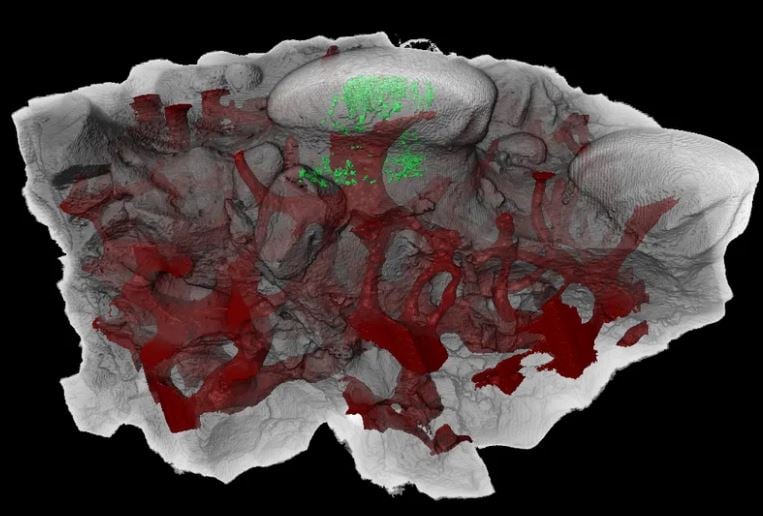
CT scan of the tooth-like structure of the ancient jawless fish Astraspis, showing green tubules containing dentin. The red areas represent the vascular system containing nerves. Photo: Yara Haridy
The sensory tissue that once existed on the exoskeletons of these ancient fishes is directly related to the “genetic toolkit” that gave rise to modern human teeth, according to the team. “This suggests that teeth may have a sensory role, even when they are not located in the mouth,” study co-author Dr. Yara Haridy, a paleontologist and evolutionary biologist at the University of Chicago, said in a statement.
Scientists initially searched the fossil record for traces of the earliest vertebrates, focusing on the Cambrian and Ordovician periods, which spanned between 541 million and 443 million years ago. One of the hallmarks of vertebrate biology is the presence of tubules containing dentin—a calcified tissue that lies just beneath the enamel of human teeth—found in tumors on the exoskeleton of ancient fish.
Using high-resolution CT scans, the team examined fossils of Anatolepis heintzi, an ancient creature once thought to be the first jawless fish. They found pores in the fossil that contained dentin-like material. However, upon closer analysis and comparison with ancient fossils and modern marine life, the researchers found that these pores resembled sensory organs in the shells of crabs rather than actual dentin.
This discovery led the team to conclude that Anatolepis heintzi was not actually a fish, but an ancient invertebrate arthropod. This led to a key finding: both vertebrates like ancient fish and arthropods once created a similar type of mineralized tissue to sense their environment. Over hundreds of millions of years of evolution, this mineralized tissue evolved into dentin—and eventually the sensitive teeth of humans today.
The study highlights that sensory structures appeared on the mineralized shells of ancient creatures at least 460 million years ago. Later, in the evolutionary stream, animals reused the same genetic mechanism to form teeth inside the mouth. “Through an evolutionary lens, the high sensitivity of human teeth is no longer a mystery, but rather reflects their ancient sensory origins in the protective armor of early vertebrates,” the team asserts.
Source: https://doanhnghiepvn.vn/cong-nghe/nguon-goc-bat-ngo-cua-rang-nguoi-tien-hoa-tu-ao-giap-cua-ca-co-dai-cach-day-hon-460-trieu-nam/20250522021849576





































































































Comment (0)